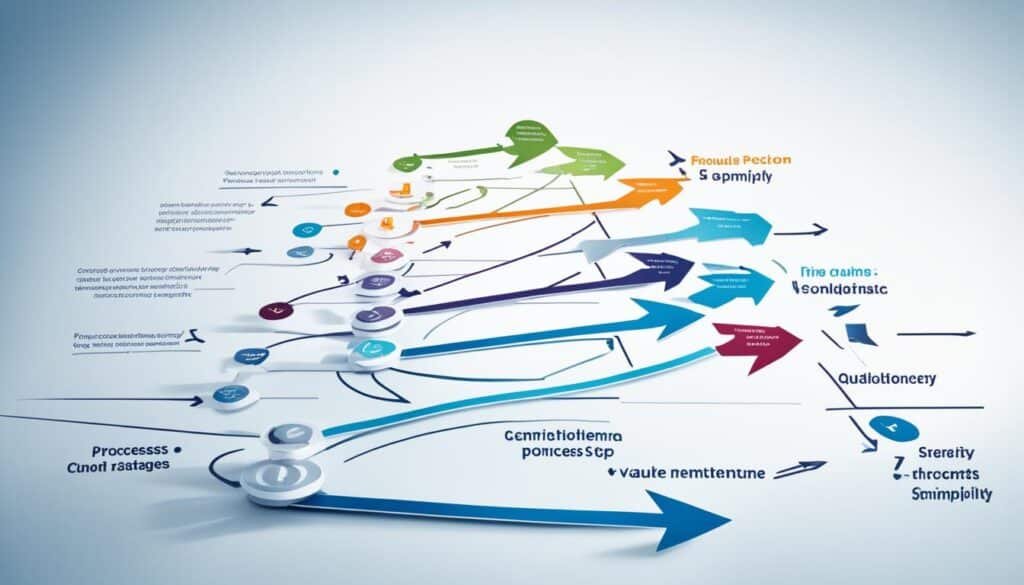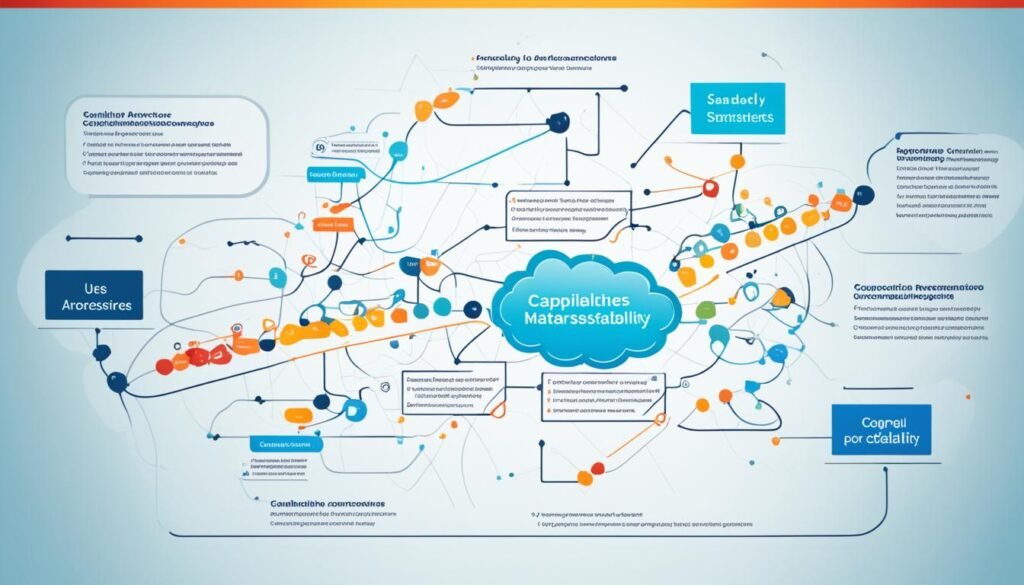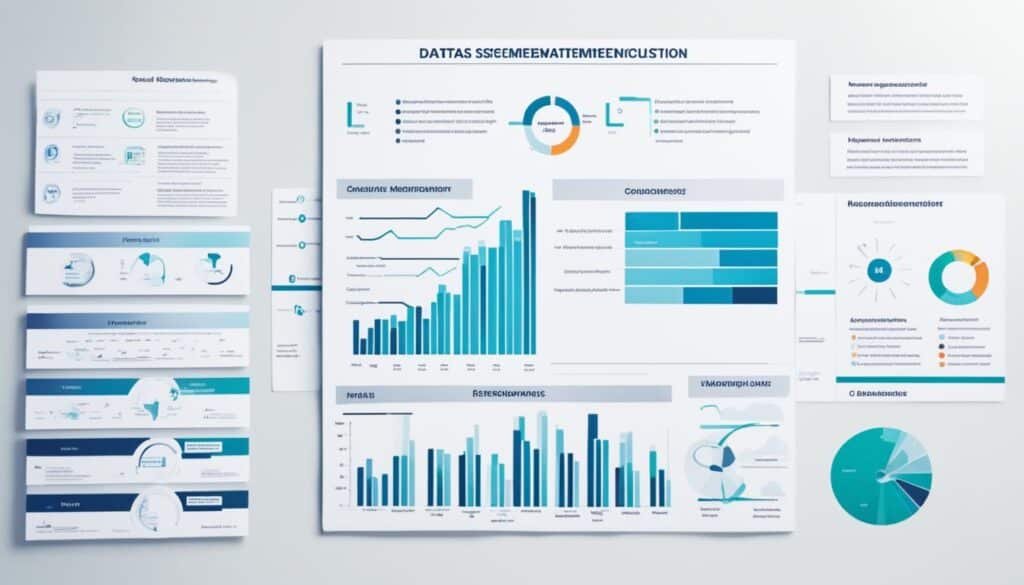Business Architecture plays a crucial role in shaping strategies, business models, and transformative processes for success. It defines the elements of business, including processes, capabilities, and value streams, and helps organizations align their objectives and achieve their business goals.
Key Takeaways:
- Business Architecture is vital in strategic planning and achieving business goals.
- It encompasses processes, capabilities, and value streams within an organization.
- Business Architecture supports alignment and objective attainment.
- It enables organizations to shape their business models and drive transformation.
- Understanding Business Architecture is essential for organizational success.
The Role of Process Architecture in Business Architecture
Process Architecture is an integral part of Business Architecture, defining the necessary levels of work to drive enterprise operations. It plays a crucial role in ensuring value creation throughout the value chain, supporting outcome-oriented measurement systems. Moreover, Process Architecture optimizes the customer journey to achieve value optimization.
Process Architecture acts as a blueprint for effective and efficient business operations. It outlines the sequence and interrelation of activities, resources, and systems required to create, deliver, and capture value. By mapping out these processes, organizations can identify opportunities for improvement, streamline workflows, and enhance overall performance.
One of the key aspects of Process Architecture is its contribution to the value chain. The value chain encompasses all the activities involved in delivering a product or service to customers and includes both primary and support activities. Process Architecture ensures that each activity within the value chain is well-defined, appropriately sequenced, and optimized for maximum value creation.
“Process architecture is like building a well-orchestrated symphony, where each process represents a musical note contributing to the harmonious customer journey.”
Process Architecture also facilitates the implementation of an outcome-oriented measurement system. Clear and measurable metrics enable organizations to track performance, identify bottlenecks, and make data-driven decisions. By continuously monitoring key performance indicators (KPIs), organizations can identify areas for improvement, drive process optimization, and enhance operational efficiency.
The customer journey is a critical focal point within Process Architecture. By understanding the customer journey and its touchpoints, organizations can tailor their processes to align with customer needs and expectations. This customer-centric approach enables organizations to deliver enhanced experiences and create long-term customer loyalty.
The integration of Process Architecture into the broader Business Architecture framework helps organizations achieve value optimization. By aligning process workflows, capabilities, and measurement systems, organizations can leverage their strengths and identify areas for improvement. This holistic approach enables organizations to drive operational excellence, deliver value to stakeholders, and gain a sustainable competitive advantage.
Benefits of Process Architecture in Business Architecture
The benefits of incorporating Process Architecture into Business Architecture are manifold. Some key advantages include:
- Enhanced operational efficiency through optimized workflows
- Improved customer experience by aligning processes with customer needs
- Increased agility and adaptability in response to changing market dynamics
- Better resource allocation based on data-driven insights
- Streamlined and standardized processes for consistency and scalability
- Identification of bottlenecks and areas for improvement through KPI monitoring
Overall, Process Architecture is a vital component of Business Architecture, providing the structure and framework for organizations to achieve their strategic objectives effectively. By carefully designing and implementing process workflows, organizations can enhance their operational performance, deliver superior customer experiences, and create sustainable value in a rapidly changing business landscape.
The Connection Between Business Strategy, Value Streams, Processes, and Capabilities

Business Strategy, Value Streams, Business Processes, and Capabilities are interconnected components of Business Architecture. Business Strategy drives the overall direction of the business, while Value Streams define the flow of value creation. Business Processes and Capabilities work together to enable the execution of work and deliver value to external stakeholders. The alignment and connection between these components are crucial for effective business operations.
Business Strategy provides the guiding framework for an organization, outlining its long-term objectives, competitive positioning, and desired outcomes. It acts as a roadmap to align the business with its goals and aspirations.
Value Streams, on the other hand, represent the series of activities and processes that transform inputs into valuable outputs. They define how value is created, delivered, and received by customers and other stakeholders. Value Streams are instrumental in understanding the end-to-end flow of work and identifying opportunities for optimization and improvement.
Business Processes and Capabilities form the operational foundation of an organization. Business Processes are the structured sets of activities that enable the execution of work and the delivery of value. Capabilities, on the other hand, represent the resources, skills, and competencies required to perform those activities effectively.
Together, Business Processes and Capabilities enable organizations to streamline operations, improve efficiency, and enhance value delivery. They play a critical role in ensuring that the right resources are available at the right time to support value creation and customer satisfaction.
The following diagram depicts the interconnectedness of Business Strategy, Value Streams, Business Processes, and Capabilities:
In this diagram, Business Strategy serves as the overarching driver, influencing the design and execution of Value Streams. Value Streams guide the design and optimization of Business Processes, while Business Processes rely on Capabilities for their successful execution.
This interconnectedness ensures that all elements of Business Architecture are aligned and work harmoniously towards achieving the organization’s strategic objectives. It enables organizations to optimize their operations, enhance their competitive advantage, and adapt to dynamic market conditions.
Understanding Business Capabilities and their Connection to Value Creation

In the realm of business architecture, understanding and harnessing the power of business capabilities is crucial to driving value creation and achieving organizational success. Business capabilities are the unique abilities and resources that an organization possesses, allowing it to create value for both internal operations and external stakeholders.
These capabilities contribute directly or indirectly to the creation of value and are utilized by business processes to execute work. Some capabilities can be automated, while others require manual work, depending on the nature of the tasks involved. To effectively manage and leverage these capabilities, organizations often create a capability map that outlines the required abilities for different levels of business performance.
By mapping out business capabilities, organizations gain a holistic understanding of their strengths and weaknesses. This visibility enables them to align their resources, skills, and processes to maximize value creation. Additionally, a capability map helps identify any gaps or areas for improvement, allowing organizations to prioritize and allocate resources effectively.
The Connection between Business Capabilities and Value Creation
Business capabilities are deeply intertwined with the concept of value creation. They form the core foundation upon which value is built and delivered. When leveraged effectively, these capabilities enable organizations to:
- Positively impact customer experience and satisfaction
- Drive operational efficiency and productivity
- Increase innovation and agility
- Enhance decision-making and strategic planning
By aligning business capabilities with value creation, organizations can ensure that their efforts and resources are targeted towards activities that deliver the most significant impact and contribute to their overall objectives.
“Business capabilities are like the pillars that support the value creation ecosystem of an organization. Understanding their connection to value creation is essential for building a strong and thriving business architecture.” – John Smith, Business Architect
When organizations comprehend the link between business capabilities and value creation, they can optimize their processes, streamline their operations, and foster a culture of continuous improvement. By maintaining a strong connection between capabilities and the value they generate, organizations can adapt to market changes, mitigate risks, and seize new opportunities.
Unlocking the Potential of Business Capabilities
To unlock the full potential of their business capabilities, organizations must focus on:
- Defining and Assessing Capabilities: Begin by identifying the critical capabilities needed to achieve strategic objectives. Assess the maturity, effectiveness, and alignment of existing capabilities to determine areas for improvement.
- Aligning Capabilities with Business Processes: Ensure that business processes are aligned with the capabilities required to execute them. By mapping capabilities to processes, organizations can optimize workflows, automate tasks, and eliminate manual work where possible.
- Driving Automation and Innovation: Leverage technology and automation to enhance the efficiency and effectiveness of business capabilities. Identify opportunities to automate manual tasks, enable self-service, and improve overall productivity.
- Continuous Improvement: Regularly review and update the capability map to adapt to changing market dynamics and business needs. Continuously seek opportunities to enhance capabilities, address gaps, and stay ahead of competitors.
By understanding the intricate connection between business capabilities and value creation, organizations can build a robust business architecture that drives growth, productivity, and long-term success.
The Significance of Business Processes and their Connection to Value Delivery

Business Processes are the activities and workflows executed by the organization to deliver value externally. They are crucial components that drive the delivery of value to customers and stakeholders. These processes are closely tied to Value Streams, which define the end-to-end scope of value creation within an organization. By aligning and optimizing business processes, organizations can enhance their value delivery and drive operational excellence.
A well-designed process architecture ensures the efficient and effective execution of work. It provides a clear framework for identifying, analyzing, and improving business processes. Process improvement initiatives focus on eliminating non-value added work, also known as waste, to streamline operations and enhance overall value delivery. By optimizing the sequence and flow of activities, organizations can reduce costs, enhance productivity, and improve customer satisfaction.
Implementing a value-centric approach in designing and managing business processes is crucial. This means prioritizing and aligning process activities with value creation for customers and stakeholders. By maintaining a customer-focused perspective, organizations can identify and prioritize value-added work, ensuring that their processes are delivering the desired outcomes. Value-centric processes drive customer satisfaction, loyalty, and ultimately, the success of the organization.
To illustrate the significance of business processes and their impact on value delivery, consider the following example:
Company XYZ, a leading e-commerce retailer, understands the importance of efficient order fulfillment for customer satisfaction. By analyzing their order fulfillment process, they identified several areas of improvement, including reducing handling time and enhancing inventory management. Through process improvement initiatives, they streamlined their order fulfillment workflow, implemented automation technologies, and optimized inventory levels. As a result, they achieved faster order processing, reduced errors, and improved delivery times, leading to increased customer satisfaction and repeat business.
Benefits of Process Improvement in Value Delivery:
- Enhanced operational efficiency
- Reduced costs and waste
- Improved customer satisfaction and loyalty
- Increased productivity and throughput
- Optimized resource allocation
- Streamlined decision-making processes
By continuously improving and optimizing their business processes, organizations can deliver value more effectively, gain a competitive advantage, and drive sustainable growth.
Understanding Value Streams and their Connection to Value Creation

Value Streams are the end-to-end flow of work that creates value for the customer. They are integral to business architecture and play a crucial role in value creation and process improvement. By analyzing and optimizing value streams, organizations can eliminate waste and achieve lean management practices.
“Value streams are the lifeline of any organization. They represent the flow of work that translates into the delivery of value to customers. By understanding and improving value streams, organizations can streamline their processes, reduce costs, and enhance customer satisfaction.”
Value-oriented process architecture is key to aligning work processes with value creation. By designing processes that focus on delivering value to the customer, organizations can maximize efficiency and minimize waste. Lean management methodologies, such as continuous improvement and eliminating non-value-added activities, are essential for optimizing value streams and driving value-centric process architecture.
Value streams can be used interchangeably with business processes within a business architecture framework. While business processes encompass the specific activities and tasks required for value creation, value streams provide a holistic view of the entire value chain. Understanding the connection and relationship between value streams and business processes is crucial for identifying areas for improvement and innovation.
A well-structured and visual representation of value streams can help organizations identify bottlenecks, redundancies, and areas for process improvement. With a clear understanding of the value stream, organizations can prioritize and implement targeted process improvement initiatives to enhance value creation and customer satisfaction.
Value Stream Analysis Example
Below is an example of a value stream analysis table that highlights each stage in the value stream, the time taken, and the value-added activities:
| Stage | Time Taken | Value-Added Activities |
|---|---|---|
| Order Placement | 2 minutes | Customer order analysis |
| Inventory Check | 1 minute | Inventory availability check |
| Order Processing | 5 minutes | Order validation and fulfillment |
| Shipping | 3 minutes | Package preparation and shipping |
| Delivery | 2 days | Shipping and tracking |
By analyzing the value stream and identifying the time taken and value-added activities at each stage, organizations can pinpoint areas for improvement. In this example, reducing the delivery time could be a significant improvement opportunity to enhance customer satisfaction.
The value stream diagram visually represents the flow of work and the value creation process. It helps stakeholders understand the end-to-end value creation process and facilitates discussions on process improvement and lean management.
Overall, understanding value streams and their connection to value creation is paramount in optimizing business processes, enhancing customer experience, and achieving lean management goals. By aligning work with value creation and continuously improving value streams, organizations can drive efficiency, eliminate waste, and deliver exceptional value to their customers.
Connecting the Concepts in Business Architecture

In the realm of Business Architecture, the concepts of information, processes, and capabilities are intricately connected through many-to-many relationships. These relationships play a pivotal role in ensuring that each component is adequately represented and linked within the architecture, creating a cohesive and integrated system.
Information serves as the foundation for effective processes and capabilities within the business architecture. It provides the necessary context and insights that drive decision-making, guiding the execution of work and influencing the overall performance of the organization.
The architecture relationships also extend to the interdependency between processes and capabilities. Processes rely on capabilities to execute work efficiently and effectively. By leveraging the specific strengths and competencies offered by capabilities, processes can align with strategic objectives and deliver value to internal and external stakeholders.
Understanding and establishing these connections is imperative for the effectiveness and adaptability of the business architecture. It allows organizations to identify areas for improvement, optimize resource allocation, and enhance operational efficiency.
“In Business Architecture, the connections between information, processes, and capabilities enable organizations to create a holistic and dynamic framework that supports their strategic goals.”
Architecture Relationships Overview:
| Concepts | Interconnections |
|---|---|
| Information | Supports processes and capabilities through data-driven insights and context |
| Processes | Utilize capabilities to execute work efficiently and effectively |
| Capabilities | Empower processes to deliver value and achieve strategic objectives |
By recognizing and optimizing these architecture relationships, organizations can create a robust and adaptable framework that drives performance and facilitates business growth.
Building Stable Capabilities and Processes from Business Objects

In Business Architecture, stable capabilities and processes are built upon the foundation of business objects. These objects represent specific types of relationships and objects of interest within the business, providing a clear and structured framework for defining capabilities and processes.
By structuring capabilities and processes around these business objects, organizations can effectively avoid redundancy and achieve a concise, complete, and non-redundant view of their business. This approach ensures that each capability and process has a specific purpose and aligns with the overall objectives of the organization.
Aligning capabilities and processes with business objects enables more effective decision-making by providing a clear understanding of how each element contributes to the broader business objectives. It also supports the implementation of a sound capability and process architecture, ensuring that resources are allocated effectively and processes are designed to deliver value.
Creating a capability map can further enhance the stability of capabilities and processes. A capability map visually represents the relationships between different capabilities, enabling organizations to identify dependencies and optimize their structure. This map helps in clearly defining the scope and boundaries of each capability, avoiding duplication of efforts and ensuring a streamlined and effective architecture.
By building stable capabilities and processes from business objects, organizations can achieve a more efficient and effective business architecture, supporting their strategic goals and objectives.
Example Capability Map:
| Capability | Description | Related Business Objects |
|---|---|---|
| Product Development | Responsible for developing new products and enhancing existing ones |
|
| Sales and Marketing | Responsible for promoting and selling products |
|
| Supply Chain Management | Responsible for managing the flow of goods and services |
|
Quote:
By structuring capabilities and processes around business objects, redundancy can be avoided, and a concise, complete, and non-redundant view of the business can be achieved.
Cross Mapping Processes and Capabilities for Value Delivery

Mapping processes and capabilities is a valuable exercise that allows organizations to gain insights into how they contribute to value delivery. By understanding the interdependencies between processes and capabilities, businesses can identify areas for improvement and change, leading to enhanced efficiency and effectiveness.
A value-oriented process architecture provides a holistic view of the value streams and their connection to capabilities. This approach allows organizations to align their processes and capabilities with the overall strategic objectives, driving optimal value delivery.
By cross-mapping processes and capabilities, organizations can achieve:
- Alignment: Mapping helps connect processes and capabilities, ensuring that they are aligned with each other and with the overall business objectives.
- Efficiency: The identification of redundant or inefficient processes allows for process improvement, streamlining operations and reducing waste.
- Adaptability: Mapping enables organizations to quickly identify areas where capability adjustments or changes are needed to meet evolving business requirements.
- Continuous improvement: By assessing the connection between processes and capabilities, organizations can identify bottlenecks and areas for improvement to enhance value delivery over time.
The Importance of Measurement in Business Architecture

Measurement plays a critical role in driving the success of Business Architecture. By providing actionable insights, it supports decision-making, resource allocation, and operational execution. The use of performance indicators, such as key performance indicators (KPIs), enables organizations to assess progress and evaluate the execution of their strategies, ensuring alignment with their goals. A well-defined measurement framework allows businesses to gain a deep understanding of what is working effectively and identify areas that require improvement. This knowledge empowers organizations to enhance their planning, alignment, and overall performance.
“Measurement is the key to unlocking the potential of Business Architecture. It equips organizations with the knowledge needed to make informed decisions, allocate resources wisely, and execute operations effectively.”
Effective measurement provides invaluable insights for decision-making at all levels of an organization. From strategic choices to operational tactics, performance indicators guide the allocation of resources towards the most impactful initiatives. With accurate and meaningful measurements, companies can optimize their business processes, capitalize on strengths, and address weaknesses. This data-driven approach not only enhances performance but also enables continuous improvement by providing a basis for monitoring progress and evaluating the success of strategic initiatives.
Business Architecture requires a comprehensive measurement framework to ensure its effectiveness. This framework should encompass both qualitative and quantitative metrics aligned with the organization’s objectives. By establishing a systematic approach to measurement, organizations can track the performance of their business processes, capabilities, and resources consistently.
Embedding a measurement culture within the organization promotes accountability and transparency. It encourages employees to focus on outcomes and results, driving operational excellence. Effective measurement also facilitates the identification of areas for improvement and innovation, enabling organizations to adapt to changing business environments.
Benefits of a Robust Measurement Framework in Business Architecture
A well-designed measurement framework in Business Architecture offers various benefits, including:
- Supporting informed decision-making by providing reliable data and insights
- Aligning resources with strategic objectives and identifying areas for optimization
- Evaluating the effectiveness and efficiency of business processes and capabilities
- Enabling performance comparisons and benchmarking against industry standards
- Driving accountability and fostering a data-driven culture within the organization
| Key Elements of a Measurement Framework | Benefits |
|---|---|
| Clear objectives and performance indicators | Ensures alignment with strategic goals and enables progress tracking |
| Data collection and analysis methods | Provides accurate and reliable data for decision-making and evaluation purposes |
| Reporting and visualization capabilities | Enables effective communication of insights and facilitates data-driven discussions |
| Continuous improvement processes | Identifies areas for optimization and fosters a culture of learning and innovation |
The implementation of a robust measurement framework in Business Architecture empowers organizations to make informed decisions, allocate resources effectively, and drive operational excellence. By leveraging performance indicators and adopting a data-driven approach, businesses can enhance their strategic alignment, optimize their processes, and ultimately achieve their desired outcomes.
The Value of Good Measurement and Quality Performance Indicators

Good measurement and quality performance indicators are essential for effective decision making and performance evaluation. Performance indicators should be relevant, comparable, time-bound, measurable, reliable, and trustworthy. By using SMART objectives (Specific, Measurable, Achievable, Relevant, Time-bound), organizations can define accurate and actionable measures that support their goals and facilitate informed decision-making.
“Measuring performance is key to understanding how well a business is performing and identifying areas for improvement. Quality performance indicators provide valuable insights and allow organizations to track progress, evaluate strategies, and make data-driven decisions.”
Effective measurement in business architecture enables organizations to:
- Assess the effectiveness and efficiency of their operations
- Evaluate the achievement of business objectives
- Identify areas for improvement and innovation
- Support informed decision-making and resource allocation
When defining performance indicators, it is important to consider these key attributes:
- Relevant: Performance indicators should align with the goals and objectives of the organization. They should provide meaningful insights and reflect the aspects of performance that matter most.
- Comparable: Indicators should allow for benchmarking and comparison over time, across departments, or against industry standards. This facilitates performance evaluation and identifies areas for improvement.
- Time-bound: Performance indicators should have a defined timeframe or frequency for measurement. This ensures timely monitoring and evaluation of progress.
- Measurable: Indicators should be quantifiable or observable, allowing for objective measurement. This enables organizations to track performance and analyze trends.
- Reliable: Data used for measurement should be consistently collected, accurate, and trustworthy. This ensures the integrity and reliability of performance indicators.
- Trustworthy: Performance indicators should inspire confidence in stakeholders and be based on credible data sources and methodologies. This promotes trust in the measurement process and facilitates informed decision-making.
SMART objectives provide a framework for developing quality performance indicators that align with an organization’s goals. By setting objectives that are Specific, Measurable, Achievable, Relevant, and Time-bound, organizations can ensure that their performance indicators are actionable, meaningful, and contribute to overall success.
Key Attributes of Quality Performance Indicators
| Attribute | Description |
|---|---|
| Relevant | Align with organizational goals and provide meaningful insights |
| Comparable | Allow for benchmarking and comparison over time or across departments |
| Time-bound | Have a defined timeframe or frequency for measurement |
| Measurable | Quantifiable or observable, enabling objective measurement |
| Reliable | Consistently collected, accurate, and trustworthy data sources |
| Trustworthy | Based on credible data sources and methodologies |
Good measurement and quality performance indicators empower organizations with the insights they need to drive strategic decision making, enhance performance, and achieve their objectives. By adopting SMART objectives and focusing on the key attributes of quality indicators, organizations can harness the power of measurement and use it as a catalyst for success.
Also Read: Efficient Small Wet Room Design Ideas And Tips
Conclusion
Business Architecture plays a critical role in achieving strategic alignment within organizations. By aligning business strategy, processes, capabilities, and resources, organizations can optimize their performance and drive success. The implementation of a well-defined measurement system, accompanied by quality performance indicators, allows organizations to monitor progress, evaluate effectiveness, and make informed decisions.
Through the strategic use of Business Architecture, organizations can enhance their competitive advantage and drive business transformation. By leveraging this framework, they can achieve their strategic objectives and propel their growth in the marketplace. In today’s fast-paced and dynamic business environment, Business Architecture provides the foundation for organizations to achieve organizational performance excellence.
By embracing Business Architecture and its measurement system, organizations can continuously evaluate and improve their operations, ensuring they remain on track towards their goals. This strategic alignment, combined with robust performance measurement, enables organizations to adapt to market changes, enhance customer satisfaction, and sustain long-term success.
FAQs
Q: What is business architecture?
A: Business architecture is a discipline that focuses on defining business strategies, structures, capabilities, processes, and metrics to drive successful business outcomes.
Q: How does business architecture help organizations?
A: Business architecture helps organizations by providing a holistic view of their business operations and enabling strategic alignment, efficient decision-making, and effective implementation of business strategies.
Q: What are the key elements of business architecture?
A: The key elements of business architecture include business capabilities, business processes, organizational structure, information flows, and technology architecture.
Q: How can businesses implement business architecture?
A: Businesses can implement business architecture by first defining their business goals and objectives, conducting a current state analysis, designing target business architecture, and then implementing the necessary changes.
Q: What is the role of a business architect?
A: A business architect is responsible for designing and implementing business architecture solutions aligned with the organization’s goals, strategies, and objectives.
Q: What are some popular enterprise architecture frameworks?
A: Some popular enterprise architecture frameworks include TOGAF (The Open Group Architecture Framework), Zachman Framework, and ArchiMate.
Q: How can business capability maps benefit organizations?
A: Business capability maps can help organizations streamline their operations, identify gaps in capabilities, prioritize investments, and drive organizational change in a structured manner.
Q: What is the value of business architecture in today’s business landscape?
A: The value of business architecture lies in its ability to provide a strategic roadmap for organizations, improve operational efficiency, enhance decision-making, and adapt to changing market conditions.
interest within the business. By structuring capabilities and processes around business objects, redundancy can be avoided, and a concise and complete view of the business can be achieved.
Source Links
- https://www.linkedin.com/pulse/business-architecture-essentials-part-5-developing-your-roger-burlton
- https://processrenewal.com/business-architecture-essentials-measuring-performance/
- https://processrenewal.com/business-architecture-essentials-aligning-capabilities-processes-business-information-connecting-dots/





